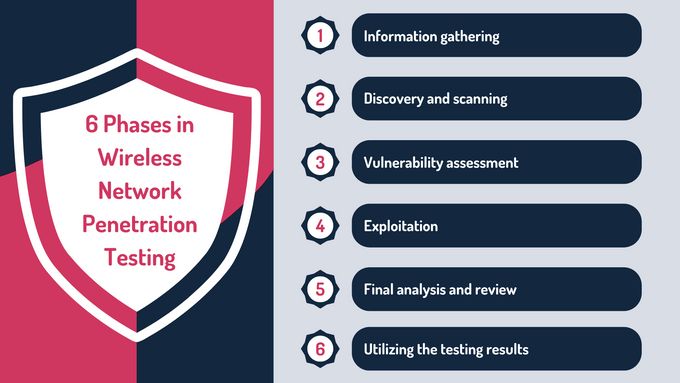How to Secure Your Wireless Network With Regular Penetration Testing
Ensure the security of your wireless network with regular penetration testing. Identify vulnerabilities, strengthen defenses, and reduce the risk of breaches.
Published April 5, 2025.

Regular penetration testing is essential for maintaining a secure wireless network. With the increasing number of cyber threats targeting wireless systems, it's crucial to stay ahead of evolving tactics by identifying vulnerabilities before they are exploited. Wireless network pentesting helps uncover hidden weaknesses in network configurations, encryption methods, and access controls. By conducting tests, you can ensure your network is resilient to potential breaches, reduce vulnerabilities, and maintain compliance with industry standards.
These proactive assessments not only protect against attacks but also help you understand how to strengthen your network’s defenses. In this post, we’ll explore how penetration testing enhances your wireless network’s overall security and reduces risk.
» Get expert penetration testing services tailored for both startups and enterprises
How Attackers Target Wireless Networks
Wireless networks can be detected using wireless network adapters, which can be either removable or built-in to systems and laptops. Once these adapters are installed and enabled, they scan for service set identifiers (SSIDs) of wireless networks within range.
The next step for an attacker is to determine whether the detected wireless network is secure or open.
A padlock symbol next to a network indicates that it is password-protected. However, if the network uses a weak password, it can be cracked using a brute force attack.
What Is Wireless Network Penetration Testing?
Wireless penetration testing is the process of assessing the security of a wireless network by simulating real-world attacks. This helps identify weaknesses that cybercriminals could exploit to gain unauthorized access, intercept communications, or compromise sensitive data.
Benefits and Limitations of Wireless Network Penetration Testing
Benefits
- Identify network vulnerabilities early, making them easier and cheaper to address
- Detect rogue access points that might be set up as fake, ensuring the integrity of the network
- Prevent sudden breaches like denial of service (DoS) or network exploitation
- Assists with meeting regulatory requirements like PCI DSS
Limitations
- Limited by resources, such as poor system specs or a low-frequency network interface card (NIC)
- Some encryption algorithms can be hard to crack, limiting the ability to fully assess the network’s security
» Read more about the benefits and importance of penetration testing in cybersecurity
Wireless Network Penetration Testing vs. Wired Network Penetration Testing
| Feature | Wireless Network Penetration Testing | Wired Network Penetration Testing |
|---|---|---|
| Access Method | Uses a wireless network adapter to scan and analyze network signals | Requires a physical connection using network cables to RJ45 ports and a NIC |
| Targeted Components | Focuses on SSIDs, encryption protocols (e.g., WPA2, WPA3), and authentication mechanisms | Evaluates internal network security, including firewalls and device authentication |
| IP Address Handling | Dynamically assigned; may change upon system restart | Typically static or assigned through DHCP but remains within the controlled network infrastructure |
| Testing Environment | Must be within signal range | Must be conducted onsite with direct access to the wired network, though it can be remote if supplied with a connection to the network—such as a VPN |
| Security Controls Tested | Tests wireless encryption, SSID security, authentication bypass methods, and rogue access points | Assesses physical security, port security, and VLAN segmentation |
» Interested in learning about other penetration testing methods? Here are our guides to white box pentesting and gray box pentesting
How Often Should You Conduct Wireless Penetration Testing?
The frequency of conducting wireless penetration tests depends on several factors, including:
Objective of the test: If an entity needs to meet compliance requirements such as PCI DSS, it is recommended to perform penetration tests at least once a year.
Rate of change to the network infrastructure: The frequency of tests should also depend on how frequently the network infrastructure changes. Testing on a regular basis helps detect vulnerabilities and reduce the attack surface as the network evolves.
Take note: With the increasing prevalence of IoT devices—such as smartwatches, fitness trackers, and home sensor-based appliances that collect and analyze vast amounts of data—more frequent penetration testing becomes necessary.
» Enhance your security with penetration testing and PCI DSS training
4 Factors That Make Wireless Networks Vulnerable
- Wireless encryption standard: Older encryption standards like WEP are highly vulnerable, while WPA2 and WPA3 offer stronger protection. Networks using outdated encryption are easier to breach.
- Encryption key length: The longer the encryption key, the harder it is to crack. Shorter keys can be guessed or brute-forced quicker.
- Password strength: Weak or commonly used passwords are easy to crack using brute force or dictionary attacks. Strong, complex passwords significantly increase security.
- Network adapter speed: The data transfer and reception rate of the attacker’s wireless network adapter can impact the efficiency of their attack, especially when capturing packets for decryption on a slower network.
» Understand how penetration testing can enhance your security
Risks of Unaddressed Wireless Vulnerabilities
- Man-in-the-middle attacks: Cybercriminals can intercept and alter network communications, potentially stealing sensitive information.
- Communication eavesdropping: Unsecured networks allow attackers to monitor and capture private conversations or data transmissions.
- Sensitive data exposure: Weak security can lead to the theft of login credentials, financial data, and other confidential information.
- Impersonation via rogue access points: Attackers can set up fake networks that appear legitimate, tricking users into connecting and unknowingly sharing sensitive data.
- Reputational damage: A security breach can harm an organization’s credibility, leading to loss of customer trust and potential legal consequences.
» Learn more about the disasters you can avoid by tackling cybersecurity on time
6 Phases in Wireless Network Penetration Testing
1. Information Gathering/Reconnaissance
In this phase, the attacker searches for the identity (SSID) of the network or any available wireless networks. Some entities broadcast their SSID while others do not. During the configuration of wireless networks/access points, it's advisable not to broadcast the SSID to prevent wardriving and warwalking attacks, which involve detecting and exploiting unprotected networks.
2. Discovery and Scanning
Once the SSID is identified, the attacker begins scanning, often using packet sniffers to monitor the packets being transferred within the network. During this phase, sensitive information should not be transmitted over HTTP, as it is unencrypted. Instead, HTTPS, which uses RSA encryption (an asymmetric algorithm with a public-private key pair), provides better security by encrypting communications.
» Learn more about asymmetric and symmetric encryption
3. Vulnerability Assessment
In this phase, the captured TCP/UDP packets are further analyzed to identify sensitive information, such as exposed ports, services running on these ports, and potential user login credentials. It's crucial to avoid using insecure ports and protocols, such as telnet (port 23) and SMTP (port 25), for transmitting sensitive data as they can be easily exploited by attackers.
» Learn more: vulnerability scan vs penetration test
4. Exploitation
Once vulnerabilities are identified, the attacker exploits these weaknesses using available tools to maximize the impact. This step simulates how an actual cybercriminal would exploit vulnerabilities in a wireless network to gain unauthorized access or escalate privileges.
5. Final Analysis and Review
This phase relies on the outcomes of the exploitation stage. It involves reviewing the results of the attack to understand the extent of the breach, which systems or data were compromised, and the overall effectiveness of the security measures in place.
6. Utilizing the Testing Results
The results of the wireless penetration test are used to achieve the attack’s objective, which could involve outcomes like DoS or identity theft. These results are crucial for improving the network’s security, identifying weaknesses, and enhancing overall protection.
» Learn more: Why penetration testing is important for your business
Alternative Options for Strengthening Wireless Network Security
Wireless Intrusion Detection Systems (WIDS)
These systems monitor your wireless network for anomalies, alerting you to potential security breaches as they occur.
Network Access Control (NAC)
NAC ensures that only authorized devices can connect to the network, preventing unauthorized access.
Regular Network Security Audits
Periodic network scans and audits, whether automated or manual, help identify vulnerabilities and keep your network secure over time.
Network Security Controls
Implementing measures such as network segmentation, VLANs, or VPNs helps protect sensitive areas and ensure data is securely transmitted across the network.
» Have a startup? Here are some cyber tips for your startup business
Secure Your Systems With Penetration Testing Today
GRSee Consulting utilizes recognized industry best practices to conduct thorough penetration testing efforts. By following frameworks like NIST SP 800-115, OWASP, and PTES, our qualified penetration testers ensure a comprehensive assessment. We prioritize strict adherence to scope and signed agreements, ensuring transparency and precision.
Our approach not only helps you identify weaknesses but also equips you with the knowledge to make informed decisions about securing your wireless network. By staying proactive, you can better prepare for potential threats, ensuring long-term protection and peace of mind in an ever-changing cyber environment
» Contact us to start leveraging the benefits of penetration testing






